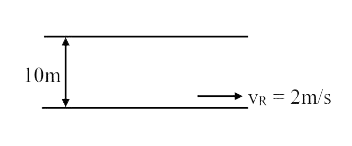The velocity of a boat in still water is 10 m/s. If water flows in the river with a velocity of 6 m/s what is the difference in times taken to cross the river in the shortest path and the shortest time. The width of the river is 80 m.
1s
10s
√32s
2 s
The correct Answer is:D
To solve the problem step by step, we need to determine the time taken to cross the river in two scenarios: the shortest path and the shortest time.
Given Data:
- Velocity of the boat in still water, Vb=10m/s
- Velocity of the river, Vr=6m/s
- Width of the river, d=80m
Step 1: Calculate the angle θ
To find the angle θ that the boat needs to make with respect to the riverbank to cross the river in the shortest path, we can use the relationship between the components of the boat's velocity.
The horizontal component of the boat's velocity must equal the velocity of the river:
Vr=Vbcos(θ)
Substituting the known values:
6=10cos(θ)
cos(θ)=610=35
Step 2: Calculate sin(θ)
Using the Pythagorean identity:
sin2(θ)+cos2(θ)=1
Substituting cos(θ):
sin2(θ)+(35)2=1
sin2(θ)+925=1
sin2(θ)=1−925=1625
sin(θ)=45
Step 3: Calculate the time taken to cross the river in the shortest path Ts
The time taken to cross the river along the shortest path can be calculated using:
Ts=dVbsin(θ)
Substituting the values:
Ts=8010⋅45=808=10s
Step 4: Calculate the time taken to cross the river in the shortest time Tt
For the shortest time, the boat travels directly across the river:
Tt=dVb
Substituting the values:
Tt=8010=8s
Step 5: Calculate the difference in time
The difference in time taken to cross the river in the shortest path and the shortest time is:
ΔT=Ts−Tt=10s−8s=2s
Final Answer:
The difference in times taken to cross the river in the shortest path and the shortest time is ΔT=2s.
---
- Velocity of the boat in still water, Vb=10m/s
- Velocity of the river, Vr=6m/s
- Width of the river, d=80m
To find the angle θ that the boat needs to make with respect to the riverbank to cross the river in the shortest path, we can use the relationship between the components of the boat's velocity.
Vr=Vbcos(θ)
Substituting the known values:
6=10cos(θ)
cos(θ)=610=35
Using the Pythagorean identity:
sin2(θ)+cos2(θ)=1
Substituting cos(θ):
sin2(θ)+(35)2=1
sin2(θ)+925=1
sin2(θ)=1−925=1625
sin(θ)=45
The time taken to cross the river along the shortest path can be calculated using:
Ts=dVbsin(θ)
Substituting the values:
Ts=8010⋅45=808=10s
For the shortest time, the boat travels directly across the river:
Tt=dVb
Substituting the values:
Tt=8010=8s
The difference in time taken to cross the river in the shortest path and the shortest time is:
ΔT=Ts−Tt=10s−8s=2s
The difference in times taken to cross the river in the shortest path and the shortest time is ΔT=2s.
Topper's Solved these Questions
- MOTION IN A PLANEBOOK - AAKASH SERIESCHAPTER - MOTION IN A PLANEEXERCISE - EXERCISE-3 (Oblique projection )
25 Videos
- MOTION IN A PLANEBOOK - AAKASH SERIESCHAPTER - MOTION IN A PLANEEXERCISE - EXERCISE-3 (Circular Motion)
7 Videos
- MOTION IN A PLANEBOOK - AAKASH SERIESCHAPTER - MOTION IN A PLANEEXERCISE - EXERCISE-3 (Relative velocity)
5 Videos
- MAGNETISMBOOK - AAKASH SERIESCHAPTER - MAGNETISMEXERCISE - ADDITIONAL EXERCISE
22 Videos
- MOTION IN A PLANEBOOK - AAKASH SERIESCHAPTER - MOTION IN A PLANEEXERCISE - QUESTION FOR DESCRIPTIVE ANSWER
7 Videos
Similar Questions
Velocity of boat in still water is 13 m/s. If water flows ina river with a velocity of 5 m/s. What is the difference in times taken by him to cross the river in the shortest path and in the shortest time. If the width of the river is 10 m.
View SolutionA river is flowing towards with a velocity of 5ms−1. The boat velocity is 10ms−1. The boat crosses the river by shortest path. Hence,
View SolutionA river is flowing towards with a velocity of 5ms−1. The boat velocity is 10ms−1. The boat crosses the river by shortest path. Hence,
View SolutionA swimmer can swim in still water with a speed of 2.5 m/s. What is the shortest time taken by him to swim across the river?

View SolutionThe speed of a swimmer in still water is 20 m//s. The speed of river water of river water is 10 m//s and due east. If he is standing on the south bank and wishes to cross the river along the shortest path the angle at which he should make his stroke w.r.t. noth is given by :-
View Solution2 km wide river flowing with a rate of 5 km/hr. A man can swim in the still water with10 km/hr. He wants to cross the river along shortest path find
Crossing time
View SolutionA person can swim in still water at 5 m/s. He moves in a river of velocity 3 m/s. First down the stream next same distance up the steam the ratio of times taken are
View SolutionA swimmer can swim in still water with speed v and the river is flowing with speed v/2. What is the ratio of the time taken to swimming across the river in shortest time to that of swimming across the river over the shortest distance ?
View SolutionA river is flowing with a velocity of 2m/s. If the width of river in 100 m and swimmer wants to cross river is shortest time, what time (in sec) would he take if velocity of swimmer in still water is 4 m/s ?
View SolutionWidth of a river is 30m, velocity is 4m/s and rowing velocity is 5m/s
(a) Make the velocity diagram for crossing the river in shortest time. Then, find this shortest time, net velocity of boatman and drigt along the river.
(b) Can the boatman reach a point just oppsite on the other shore? If yes then make the velocity diagram, the direction in which the should row his boat and the time taken to cross the river in this case.
(c) How long will it iake hom to row 10m up the stream and then back to his starting point?
View Solution
